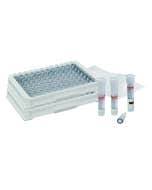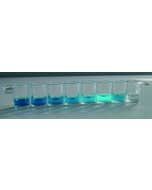ELISA Test Kit Determine the concentration of an antibody in a solution
Topics covered:
- Performing a colorimetric titration protocol (application in medical diagnostics)
- Vaccination and adaptive immune responses to a pathogen
- Antigen-antibody relationship
Principle and objective:
Carry out an immunotitration protocol to determine the quantity of specific antibodies that have reacted with the antigens fixed on the provided cup bottoms, with a sensitivity on the order of μg/ml. The titration is carried out using a standard range that allows for establishing a scale of reference colors.
The objective is to determine the concentration of antibodies present in a serum sample to determine if the individual is immunized against the studied antigen or not.
The experiment lasts for one 50-minute session. Reagents are provided for 24 pairs.
Composition:
24 strips of 8 "coated" cupules with BSA (antigen), 2 strip holders, 1 tube of serum from BSA-immunized rabbit, 1 tube of serum from non-immunized rabbit, 1 tube of secondary reactive antibodies coupled with an enzyme, Tween solution, PBS 10x dilution buffer, 1 tube of enzyme substrate (TMB)
Additional necessary equipment: P20 micropipettes and tips
Comments:
We offer a realistic ELISA test as in a laboratory. To further enhance the experience, at the end of the manipulation, each group can take a photo of the strip (using a smarExperimenthone, for example). Using an image processing software (Mesurim), they will create a calibration curve to more precisely determine the antibody concentration in the serum and validate their initial visually determined conclusion.
| Thématique TP | Biologie |







